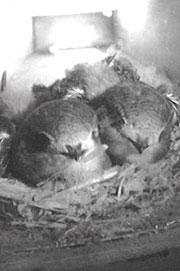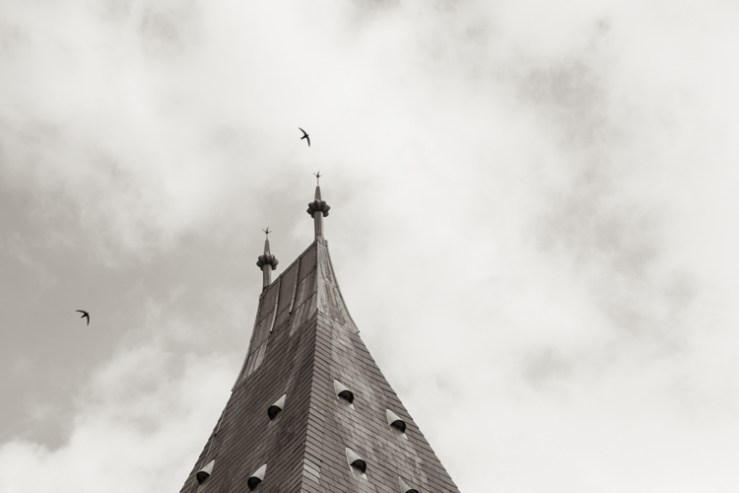
The Museum is really pleased to be a partner in Oxford Swift City, a major new initiative to protect and nurture the city’s populations of swifts. Here Keo Baxendine at RSPB Midlands tells us more about the project…

The swifts have just returned to the UK after their long migration from Africa. At the Museum they have begun circling the tower where they nest each year.
These charismatic birds, Apus apus, are commonly recognised throughout the UK as a sign of summer. They also have a long cultural association with Oxford as a symbol of knowledge and dexterity. Yet sadly, the national swift population has fallen by 42 per cent since 1994, due to a lack of nesting sites and food.
The Oxford Swift City project hopes to turn the birds’ fortunes around by protecting existing swift nesting sites as well as encouraging the creation of new ones. Last night, project partners and guests gathered at the Museum to kick off the project.
The swift is an iconic species whose appearance announces the start of summer. Sadly the swift is in trouble. Numbers have dropped dramatically, putting the birds at risk of disappearing completely from the UK. The Oxford Swift City community project provides local people with a great opportunity to learn about this important bird and discover how to take action to help give swifts a home in Oxford.
– Lucy Hyde, Oxford Swift City Project Officer

There are lots of ways to get involved: take part as a swift survey volunteer; help out at a community event; or just put up a nestbox or plant wildflowers in the garden. You can also join a local swift expert on a number of ‘swift walks’ through Oxford over the summer.
The colony of swifts which nests in the Museum has been the subject of a research study since 1948, and is one of the longest continuous studies of a single bird species in the world. This work has contributed much to our knowledge of the swift.
Fittingly, Oxford Swift City is running a ‘Swift Tower’ design competition. Subject to approval, the winning design will be constructed in Oxford next year, providing ideal nesting spaces for swifts – so get scribbling!
Funded by the Heritage Lottery Fund, the RSPB-led Oxford Swift City project is supported by many local partners, including Oxford University, Oxford University Museum of Natural History, Oxford City Council, Thames Valley Environmental Records Centre, Environment Resources Management and the local Wildlife Trust.
For more information please email oxfordswiftcity@rspb.org.uk.



Swifts are my favourite birds and watching them fly and hunt is thrilling. I do not think their plight is given sufficient publicity, nor proper details for putting up nesting places for them, such as where best to place a box (north/ south/east/west facing) and where the aperture should be(bottom/side).
Response from George Candelin
Hello Suzette,
Swift boxes can be mounted on a wall with any compass direction; the important thing is to mount them as close to the roof level as possible.
The museum swifts appear to prefer an entrance hole on the bottom of the box, this should not be too large in order to keep starlings out. There is a wealth of information at http://www.swift-conservation.org/Nestboxes%26Attraction.htm .
I regularly watched the webcam with the 3 baby swifts who have now flown the nest (July 2017). I was very worried for them while watching them being constantly disturbed and attacked by the blood sucking mites which fed on them. On the day when I noticed that the young swifts had first left their nest the parasites were visible crawling in and out and around in search of the little birds. Is it possible to treat the nests and kill these parasites while the swifts have gone abroad for the winter?
Thanks Peter, good question. Here’s a response from our swift keeper George Candelin:
“These ‘sucking mites’ are Hippoboscid flies called Crataerina pallida or commonly ‘swift flat-fly’ and are part of the natural lifecycle of swifts. They are unusual in that they do not lay eggs but instead produce a fully formed larva which pupates within the hour to lay dormant in the nest. We empty the boxes at the end of the season and sterilise the old nests by freezing for nearly 8 months before putting them back in the spring. Any flat-flies that you see will have come in with birds having been acquired elsewhere. Flat-flies feed about once a week taking 0.05ml of blood, so as long as there are not too many in the nest, they have no adverse effect on the birds and may even have some form of benefit to them although we do not yet understand what that might be.”
Well done, Oxford, absolutely fantastic work boosting the numbers of, in my view, this most wonderful of birds! What can we do about the lack of food for them?
Thanks for your comment and question. Here’s a response from our swift keeper George Candelin:
“The insect population of the UK has been reducing at a tremendous rate for years. Swifts tend to feed their young on small beetles (mainly pollen beetles and flea beetles), plus spiderlings and aphids. Fields of yellow flowering rape have been of great benefit to swifts, but pesticides and herbicides have made finding food more difficult. Grow wildflowers in your garden, if you have to spray just use soapy water; pull weeds don’t spray them.”